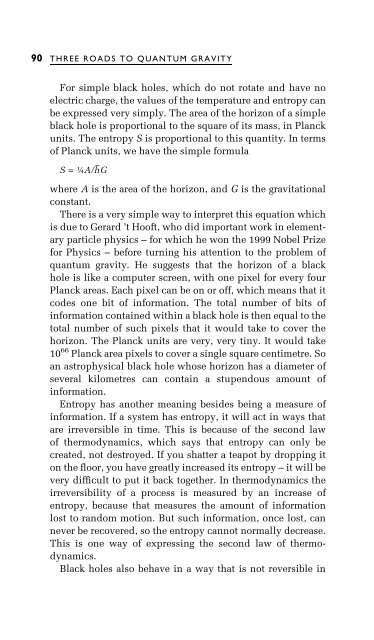Three Roads To Quantum Gravity
Three Roads To Quantum Gravity
Three Roads To Quantum Gravity
Create successful ePaper yourself
Turn your PDF publications into a flip-book with our unique Google optimized e-Paper software.
90 THREE ROADS TO QUANTUM GRAVITY<br />
For simple black holes, which do not rotate and have no<br />
electric charge, the values of the temperature and entropy can<br />
be expressed very simply. The area of the horizon of a simple<br />
black hole is proportional to the square of its mass, in Planck<br />
units. The entropy S is proportional to this quantity. In terms<br />
of Planck units, we have the simple formula<br />
S = ˆA/h Å G<br />
where A is the area of the horizon, and G is the gravitational<br />
constant.<br />
There is a very simple way to interpret this equation which<br />
is due to Gerard 't Hooft, who did important work in elementary<br />
particle physics ± for which he won the 1999 Nobel Prize<br />
for Physics ± before turning his attention to the problem of<br />
quantum gravity. He suggests that the horizon of a black<br />
hole is like a computer screen, with one pixel for every four<br />
Planck areas. Each pixel can be on or off, which means that it<br />
codes one bit of information. The total number of bits of<br />
information contained within a black hole is then equal to the<br />
total number of such pixels that it would take to cover the<br />
horizon. The Planck units are very, very tiny. It would take<br />
10 66 Planck area pixels to cover a single square centimetre. So<br />
an astrophysical black hole whose horizon has a diameter of<br />
several kilometres can contain a stupendous amount of<br />
information.<br />
Entropy has another meaning besides being a measure of<br />
information. If a system has entropy, it will act in ways that<br />
are irreversible in time. This is because of the second law<br />
of thermodynamics, which says that entropy can only be<br />
created, not destroyed. If you shatter a teapot by dropping it<br />
on the ¯oor, you have greatly increased its entropy ± it will be<br />
very dif®cult to put it back together. In thermodynamics the<br />
irreversibility of a process is measured by an increase of<br />
entropy, because that measures the amount of information<br />
lost to random motion. But such information, once lost, can<br />
never be recovered, so the entropy cannot normally decrease.<br />
This is one way of expressing the second law of thermodynamics.<br />
Black holes also behave in a way that is not reversible in



![arXiv:1001.0993v1 [hep-ph] 6 Jan 2010](https://img.yumpu.com/51282177/1/190x245/arxiv10010993v1-hep-ph-6-jan-2010.jpg?quality=85)


![arXiv:1008.3907v2 [astro-ph.CO] 1 Nov 2011](https://img.yumpu.com/48909562/1/190x245/arxiv10083907v2-astro-phco-1-nov-2011.jpg?quality=85)








![arXiv:1002.4928v1 [gr-qc] 26 Feb 2010](https://img.yumpu.com/41209516/1/190x245/arxiv10024928v1-gr-qc-26-feb-2010.jpg?quality=85)
![arXiv:1206.2653v1 [astro-ph.CO] 12 Jun 2012](https://img.yumpu.com/39510078/1/190x245/arxiv12062653v1-astro-phco-12-jun-2012.jpg?quality=85)
